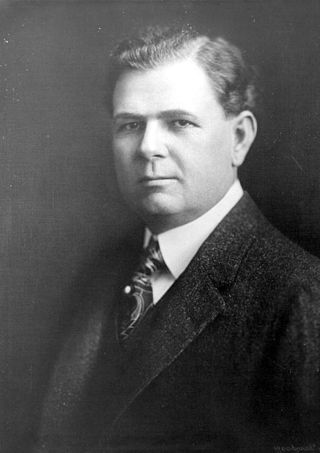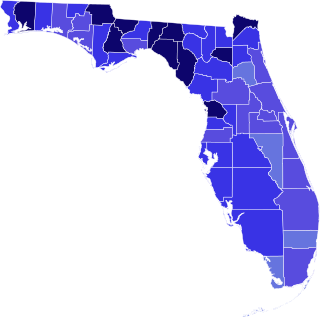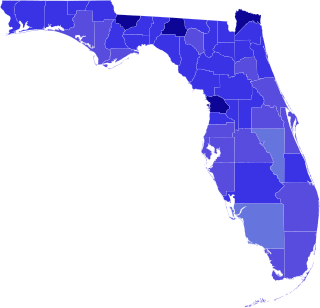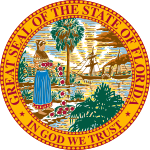
The 1986 United States Senate elections were elections for the United States Senate. Held on November 4, in the middle of Ronald Reagan's second presidential term, the 34 seats of Class 3 were contested in regular elections. The Republicans had to defend an unusually large number of freshman Senate incumbents who had been elected on President Ronald Reagan's coattails in 1980. Democrats won a net of eight seats, defeating seven freshman incumbents, picking up two Republican-held open seats, and regaining control of the Senate for the first time since January 1981. This remains the most recent midterm election cycle in which the sitting president's party suffered net losses while still flipping a Senate seat.

Park Monroe Trammell, was an American attorney and politician from the state of Florida. Trammell represented Florida in the United States Senate from 1917 until his death in 1936. As chair of the Senate Naval Affairs Committee, Trammell was essential in the creation of several laws that revitalized the United States Navy. Trammell previously served as the Governor of Florida and Florida Attorney General.

John Wellborn Martin was an American politician who served as the 24th Governor of Florida, from 1925 to 1929. He also served as Mayor of Jacksonville, Florida, from 1917 to 1923. Born in Plainfield in Marion County, Florida, Martin and his family moved to Jacksonville in 1899. Despite only about four years of formal education, he studied law and was admitted to the Florida Bar in 1914. Three years later, Martin ran for Mayor of Jacksonville and easily defeated incumbent J. E. T. Bowden, becoming the city's youngest mayor at age 32. He was easily re-elected twice in landslide victories and served three consecutive terms.

The 1970 United States Senate elections was an election for the United States Senate. It took place on November 3, with the 33 seats of Class 1 contested in regular elections. Special elections were also held to fill vacancies. These races occurred in the middle of Richard Nixon's first term as president. The Democrats lost a net of three seats, while the Republicans and the Conservative Party of New York picked up one net seat each, and former Democrat Harry F. Byrd Jr. was re-elected as an independent.

The 1962 United States Senate elections was an election for the United States Senate. Held on November 6, the 34 seats of Class 3 were contested in regular elections. Special elections were also held to fill vacancies. They occurred in the middle of President John F. Kennedy's term. His Democratic Party made a net gain of four seats from the Republicans, increasing their control of the Senate to 68–32. However, this was reduced to 67–33 between the election and the next Congress, as on November 18, 1962, Democrat Dennis Chávez, who was not up for election that year, died. He was replaced on November 30, 1962, by Republican appointee Edwin L. Mechem. Additionally, Democrat Strom Thurmond became a Republican in 1964, further reducing Democrats to 66–34. This was the first time since 1932 that Democrats gained seats in this class of Senators.

The 1958 United States Senate elections were elections for the United States Senate which occurred in the middle of President Dwight D. Eisenhower's second term. Thirty-two seats of Class 1 were contested in regular elections, the new state of Alaska held its first Senate elections for its Class 2 and 3 seats, and two special elections were held to fill vacancies.

The 1950 United States Senate elections occurred in the middle of Harry S. Truman's second term as president. The 32 seats of Class 3 were contested in regular elections, and four special elections were held to fill vacancies. As with most 20th-century second-term midterms, the party not holding the presidency made significant gains. The Republican opposition made a net gain of five seats, taking advantage of the Democratic administration's declining popularity during the Cold War and the aftermath of the Recession of 1949. The Democrats held a narrow 49-to-47-seat majority after the election. This was the first time since 1932 that the Senate majority leader lost his seat, and the only instance of the majority leader losing his seat while his party retained the majority.

The 1936 United States Senate elections coincided with the reelection of President Franklin D. Roosevelt. The 32 seats of Class 2 were contested in regular elections, and special elections were held to fill vacancies. The Great Depression continued and voters backed progressive candidates favoring Roosevelt's New Deal in races across the country. The Democrats gained 5 net seats during the election, and in combination with Democratic and Farmer–Labor interim appointments and the defection of George W. Norris from the Republican Party to become independent, the Republicans were reduced to 16 seats. Democrats gained a further two seats due to mid-term vacancies. The Democrats' 77 seats and their 62-seat majority remain their largest in history.

The 1990 Florida gubernatorial election took place on November 6, 1990. Incumbent Republican governor Bob Martinez ran for a second term in office, but was defeated by Democratic challenger Lawton Chiles, a former U.S. senator.

The 1970 Florida gubernatorial election took place on November 3, 1970, to determine the governor and lieutenant governor of Florida, concurrent with the election to the United States Senate, elections to the United States House of Representatives, and various state and local elections.

The 1976 United States Senate election in Florida was held on November 2, 1976. Incumbent Democratic U.S. Senator Lawton Chiles won re-election to a second term.

The 1916 Florida gubernatorial election was held on November 7, 1916, to determine the Governor for the State of Florida. Democratic incumbent Governor Park Trammell was term-limited and could not run for re-election.

The 1958 United States Senate election in Florida was held on November 4, 1958.

The 1916 United States Senate election in Florida was held on November 7, 1916.

The 1922 United States Senate election in Florida was held on November 7, 1922.

The 1934 United States Senate election in Florida was held on November 6, 1934.

The 1940 United States Senate election in Florida was held on November 5, 1940.

The 1912 Florida gubernatorial election was held on November 5, 1912. Incumbent Governor Albert W. Gilchrist was term-limited. Democratic nominee Park Trammell was elected with 80.42% of the vote.

The 1908 Florida gubernatorial election was held on November 3, 1908. Incumbent Governor Napoleon B. Broward was term-limited. Democratic nominee Albert W. Gilchrist was elected with 78.82% of the vote.

The 1936 United States Senate special election in Florida was held on November 3, 1936. Charles O. Andrews was easily elected to fill the seat.























